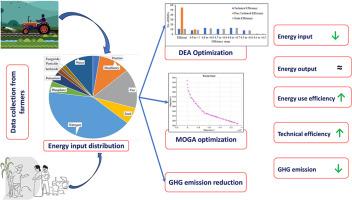基于数据包络分析和多目标遗传算法的稻麦系统能耗和温室气体排放优化研究
IF 9.4
1区 工程技术
Q1 ENERGY & FUELS
引用次数: 0
摘要
本研究旨在利用数据包络分析法和多目标遗传算法,优化印度恰蒂斯加尔邦、比哈尔邦和旁遮普邦水稻-小麦种植系统的能源使用,减少温室气体排放。对 65 个农场的能源投入(包括劳动力、机械、柴油、化肥、除草剂、杀虫剂、杀菌剂和灌溉)进行了评估。平均能源投入为 39,706 ± 4877 兆焦耳/公顷-1,平均产出为 140,961 兆焦耳/公顷-1。能量消耗最高的是氮肥(15995 ± 2973 兆焦耳/公顷-1)、柴油(5978 ± 358 兆焦耳/公顷-1)和机械(4438 ± 141 兆焦耳/公顷-1)。数据包络分析结果表明,26.15% 的农场达到了技术效率,平均技术效率得分为 0.833,规模效率为 0.838。多目标遗传算法进一步优化了能源使用,与数据包络分析结果相比,减少了 13,440 兆焦耳/公顷。传统耕作系统每公顷排放 67,410 千克二氧化碳当量,而优化后的农场每公顷减少 34 千克二氧化碳当量。这些研究结果突出表明,通过优化投入品管理,最大限度地减少水稻-小麦系统对化肥、柴油和机械的依赖,促进更可持续的农业实践,具有大幅节能和减少温室气体排放的潜力。本文章由计算机程序翻译,如有差异,请以英文原文为准。

Data envelopment analysis and multi-objective genetic algorithm based optimization of energy consumption and greenhouse gas emissions in rice-wheat system
This study seeks to optimize energy use and reduce greenhouse gas emissions in rice-wheat cropping systems across Chhattisgarh, Bihar, and Punjab, India, using Data Envelopment Analysis and a multi-objective genetic algorithm. Energy inputs, including labour, machinery, diesel, fertilizers, herbicides, pesticides, fungicides, and irrigation, were evaluated across 65 farms. The average energy input was 39,706 ± 4877 MJ ha⁻1, while the average output was 140,961 MJ ha⁻1. The highest energy expenditures were attributed to nitrogen (15,995 ± 2973 MJ ha⁻1), diesel (5978 ± 358 MJ ha⁻1), and machinery (4438 ± 141 MJ ha⁻1). Data envelopment analysis results indicated that 26.15 % of farms operated at technical efficiency, with an average technical efficiency score of 0.833 and scale efficiency of 0.838. The Banker, Charnes, and Cooper model suggested an optimal energy input of 24,635 MJ ha⁻1. multi-objective genetic algorithm further optimized energy use, achieving a reduction of 13,440 MJ ha−1 compared to data envelopment analysis results alone. Conventional farming systems emitted 67,410 kg CO2-eq ha⁻1, while optimized farms achieved a reduction of 34 kg CO2-eq ha⁻1. These findings highlight the potential for substantial energy savings and greenhouse gas reductions through optimized input management, promoting more sustainable agricultural practices by minimizing reliance on chemical fertilizers, diesel, and machinery in rice-wheat systems.
求助全文
通过发布文献求助,成功后即可免费获取论文全文。
去求助
来源期刊

Energy
工程技术-能源与燃料
CiteScore
15.30
自引率
14.40%
发文量
0
审稿时长
14.2 weeks
期刊介绍:
Energy is a multidisciplinary, international journal that publishes research and analysis in the field of energy engineering. Our aim is to become a leading peer-reviewed platform and a trusted source of information for energy-related topics.
The journal covers a range of areas including mechanical engineering, thermal sciences, and energy analysis. We are particularly interested in research on energy modelling, prediction, integrated energy systems, planning, and management.
Additionally, we welcome papers on energy conservation, efficiency, biomass and bioenergy, renewable energy, electricity supply and demand, energy storage, buildings, and economic and policy issues. These topics should align with our broader multidisciplinary focus.
 求助内容:
求助内容: 应助结果提醒方式:
应助结果提醒方式:


